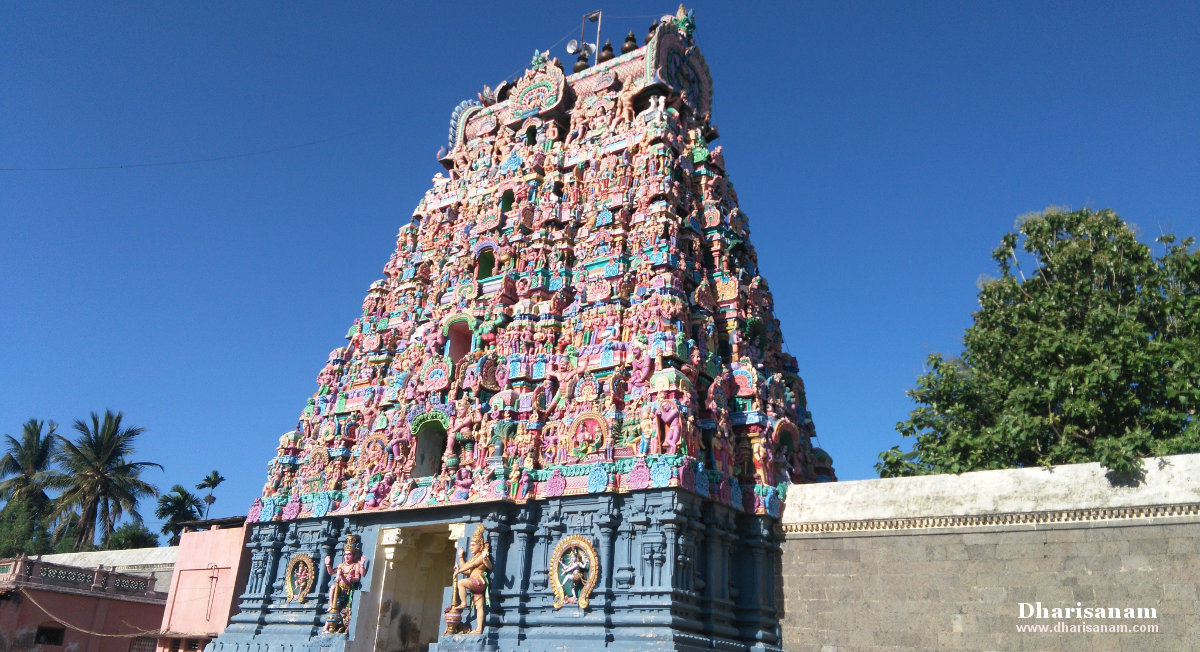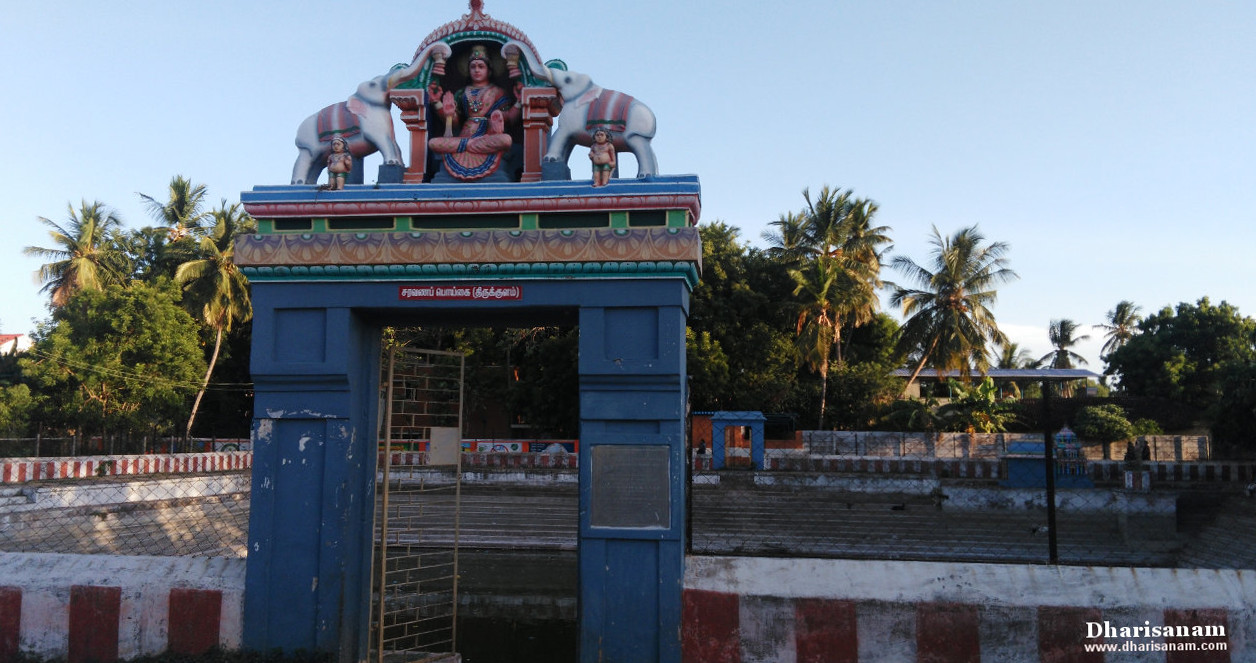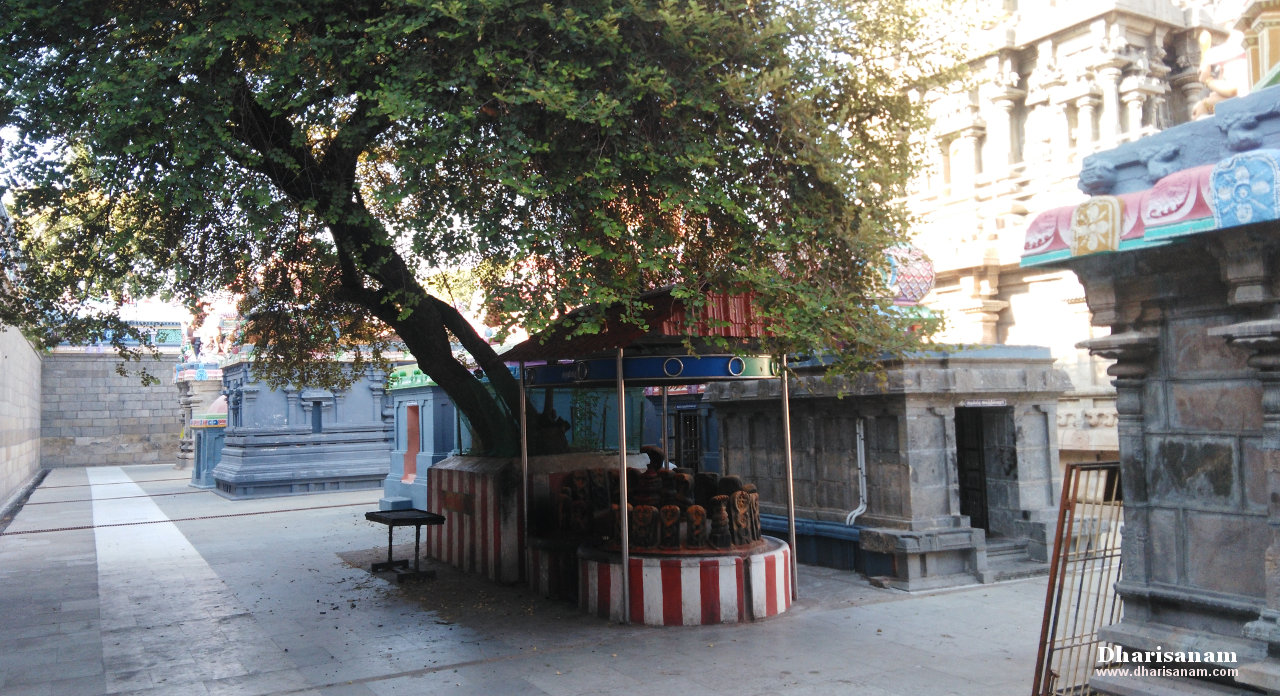Visited on: 23rd September, 2018.
Location
Keezhvelur is situated at a distance of about 14 kms from Thiruvarur on the Thiruvarur to Nagapatinam route. In fact, it is midway in between Tiruvarur and Nagappattinam.
There is a railway station in Keezhvelur and this temple is about 2 kms away from it. Nearest Airport is located at Trichy.
Other Devara Paadal Petra Shiva Sthalams near this place are –
Thevur, Sikkal, Nagapattinam, Thirumaraikkadu, Agathiyanpalli and Kodiyakkarai.
General Information
| Moolavar | Sri Kediliyappar, Sri Atchayalingeswarar |
| Ambal | Sri Vanamulai Nayagi, Sri Sundara Gujambal |
| Theertham (Holy water) | Saravana Theertham |
| Sthala Vriksham (Sacred Tree) | Ilanthai tree (Badari) |
| Pathigam (Hymn) rendered by | Saint Thirugnanasambanthar-1 Saint Thirunavukarasar (Appar)-1 |
- This is one of the 276 Devara Paadal Petra Shiva Sthalams and 84th Shiva Sthalam on the Southern bank of the river Cauvery in Chozha Nadu (Thenkarai).
- Lord Shiva in this temple is a Swayambumurthi (self-manifested).
- This temple is counted as one of the Maadak Koils built by King Kochengat Cholan, one of the 63 Nayanmars.
- This temple is also known as “Kubera Sthalam”.
- This east facing temple has two corridors and its main tower (Rajagopuram) has 7-tiers.
- The last consecration ceremony (Maha Kumbabishekam) took place on 01.05.2015 and prior to that on 11.04.1999 and 01.09.1963.
History of the Temple
The legend is that once upon a time, when the Devas and Asuras were churning the “Thiruparkadal” ocean to extract nectar, it is believed that a drop of the nectar fell on the ground at two places – one in north India and the other one at this place. The place where it fell in north India is known as “North Badarikaranyam” (present Badrinath in Uttarakand state) and this place is known as “South Badarikaranyam”. Badri refers to “Elanthai” tree and once this region was a forest densely covered with badri trees. The sthalaviruksham of this temple is also badari tree.
There are three stone inscriptions in this temple - two belong to the Tirubuvana Chakravarthi Raja Raja Cholan and one belongs to Tanjore Maratha king Thulajaji.
As Lord Murugan (“Vel”) worshiped Lord Shiva here, this place gets the name Velur.
The temple is built at an elevation of about 21 feet with 18 steps on the hillock and is known as “Chithira Kooda Parvadam”.
This temple is under the administrative control of the Hindu Religious and Charitable Endowments Department of Government of Tamil Nadu (HR&CE).




Legend
According to sthalapuranam, Lord Murugan sought the blessings of Lord Shiva to cleanse himself of the sin “Veerahathi dosham” that he accrued from killing demon Surapadman. Lord Shiva advised him to go to this place and perform penance. Lord Murugan reached this place and made a Vinayakar with turmeric (Manjal in Tamil) powder and started his worship. That place near Velur is now called Manjadi. He also created a pond using his spear (‘Vel’). With the help of Indra and Maya (the divine sculptor), he built a beautiful temple for Lord Shiva.
During the course of his penance, Veerahathi in the form of “mayas” began to interfere in his worship. He sought the help of Lord Shiva who in turn asked Goddess Parvathi to protect Lord Murugan’s penance. Goddess Parvathi appeared there as “Badrakaali” and protected him by covering all the four directions and the sky. As she covered all the five directions, she is praised here as “Anju Vattathu Amman” (“anju” means five and “vattam” means circle in Tamil). She is also known here as Kaali.
It is believed that Sage Agasthiyar had performed penance here. Lord Shiva was pleased with his prayers and allowed him to witness his wedding darshan as well as his cosmic dance. This is the only place where Lord Shiva danced on a different leg (left leg on the ground and his right leg lifted). It is believed that while he was dancing, Mahavishnu played an instrument (“Mathalam”), Mahalakshmi clapped her hands, Brahma played thalam, Saraswathi played veena, Indra played flute, Vinayakar and Murugan both sung songs while Sages Agasthiyar, Pathanjali and Viyakrapathar worshiped and enjoyed the beautiful dance. The procession idols depicting this dance performance can be seen in the main hall.
It is believed that Kuberan visited this place on an “Atchaya Tirithia” day and worshiped the lord. Lord Shiva gave him nine pots full of wealth, which included the “Sanga Nidhi” and “Paduma Nidhi”.
It is believed that Mahavishnu, Brahma, Krishna, Murugan, Indra, Kuberan, Agni, Vayu, Yama, Chandran, Navagrahams, Sage Agasthiyar, Sage Vashistar, Sage Markandeya, Adhiseshan, Saints Thirugnanasambanthar and Appar have worshiped the lord here.
Deities in the temple
Other than the shrines of Lord Shiva and Goddess Parvathy, shrines and idols of Badari Vinayakar, Murugan, Natarajar, Somaskandar and Kuberan can be seen in the main hall and the corridors.
In the “koshtam” (place surrounding the sanctum sanctorum), idols of Lakshmi Vinayakar, Subramanyar, Dakshinamurthy, Anjuvattammai, Ashta puja Bairavar, 63 Nayanmars, Jura devar, Anjaneyar, Venkatachalapathi, Kuberan, Kasi Viswanathar, Kailasanathar, Brihadeeswarar, Annamalaiyar, Jambukeswarar, Aalungoveswarar, Maha Lakshmi, Indiran, Narthana Vinayagar, Kalyana Sundarar, Bhadrakali, Sage Agasthiyar, Ekambareswarar, Chozheeswarar, Kalahastheeswarar, Lingothbavar, Brahma, Durgai and Chandikeswarar can be seen.
There is a lingam under the sthala viruksham that is believed to have been worshiped by Sage Agasthiyar.
All the idols of Navagraham are seen in a single row facing Lord Shiva. Normally in other temples, they are in the 3X3 matrix.







Salient Features
This temple is huge in size and has marvellous architecture. There are two adjacent towers (vimanam) on the sanctum sanctorum – one for the “moolavar” and the other one is for Somaskandar. The tower on the moolavar is built with granite and has a lot of beautiful sculptures.
In this temple, the shrines of both Lord Shiva and Goddess Parvathy are facing the east direction. Goddess Parvathy’s shrine is on the right side of Lord Shiva’s shrine. This is considered to symbolise their wedding posture.
This temple is considered to be significant for its three important attributes – Moorthy, Sthalam and Theertham - glory of Lord, sacredness of the land and the auspicious temple tank.
In the koshtam near Lord Dakshinamurthy’s shrine, there are some beautiful idols including those of Veena Dakshinamurthy (2), Pitchandavar and Sri Katchiyalitha Nayakar.
The lord of this temple is called Akshayalingeswarar. “kshayam” means destruction and “A-kshayam” means the inverse of that. Another reason for this name is that this lord is believed to be the owner of the “Akshaya bowl” (the bowl of wealth). In Tamil, he is praised as “Sri Kediliyappar” because “kedu” means destruction.
At many places in his hymn, Saint Thirugnanasambanthar refers to this temple as “perunthirukkoil” - meaning a big temple. Saint Thirunavukkarasar mentioned in his hymn that whosoever worships the lord here will be relieved from all kinds of detriments
It is believed that the idol of Lord Murugan here was made by the same sculptor who made Lord Murugan’s idol in Tiruchendur.
Goddess Kaali is made of ‘sand’ (‘Sudhai’), hence only “Punugu” (civet) and sambirani thailam are applied once in a while. The Anju Vattathu Amman Koil here is famous among devotees.
A huge and beautiful statue of Nandhi, made of sand (“sudhai”) can be seen next to the flag post.
There are nine (nava) Theerthams related to this temple – Brahma Theertham, Yama Theertham, Agni Theertham, Soorya Theertham, Chandra Theertham, Indra Theertham, Sesha Theertham, Saravana Poigai and Kubera Theertham.
Lord Vinayakar of this temple is praised as Lord Badri Vinayakar. Elanthai tree (Badri) is the sthala viruksham of this temple.
The idol of Natarajar here is incredibly beautiful and it dates back to the 18th century. The lord is seen here standing with his left leg and his right one is lifted above. Here he is seen with ten hands. This is a very unique posture.
Behind the sanctum sanctorum, on either sides of Lord Lingothbavar, there are idols of Lord Mahavishnu and Lord Brahma in a worshipping posture. Devotees can enjoy the darshan of all the three lords (Trimurthys) – Brahma, Vishnu and Shiva. This is considered to be very auspicious.
It is believed that King Kochengat Chola built about 70 “Madakkoils”. The distinguishing feature of a Madakkoil is that it is not easily approachable by an elephant. He built these temples at an elevation and there are a few steps that need to be climbed before seeing the lord. Also, the sanctum sanctorum’s (Karpagragam) entrance is narrow such that no elephant can enter it.
This temple has been glorified by saint Muthuswamy Dheekshidhar in his song “Akshaya Linga Vibho” set in the raga “Sankarabharanam”.






Greatness of this temple
Devotees believe that by worshiping the lord here, they will be absolved of the all the sins they might have accrued from their previous births.
This is a “parihara sthalam” for all kinds of doshas including “Pithru dosham”.
Important Festivals
Poojas are performed here six times every day.
The annual Bhramotsavam is celebrated in the month of Chittirai (Apr-May). During this time, the “Rishabha vaahana utsavam” and the “Sapta Sthana utsavam” are important festivals that are celebrated in a grand manner.
Some of the other important festivals celebrated in this temple are –
Aani Thirumanjanam in the Tamil month of Aani (June-July),
Aadi Pooram in the Tamil month of Aadi (July-Aug),
Vinayakar Chaturthi in the Tamil month of Aavani (Aug-Sept),
Navarathri in the Tamil month of Purattasi (Sept-Oct),
Skanda Shashti and Annabishekam in the Tamil month of Aippasi (Oct–Nov),
Thiru Karthikai and Somavaram in the Tamil month of Karthikai (Nov-Dec),
Thiruvadhirai in the Tamil month of Markazhi (Dec-Jan),
Makara Sankranthi in the Tamil month of Thai (Jan-Feb),
Shivrathri in the Tamil month of Masi (Feb-Mar) and
Panguni Uthiram in the Tamil month of Panguni (Mar-Apr).
Pradosham, Pournami and Sankatahara Chaturthi are also observed regularly.
Temple Timings
From 06:30 AM to 12:00 Noon and from 04:00 PM to 09:00 PM.
Temple Address
Sri Kediliappar /Sri Akshaya Linga Swamy Temple,
Keezh Velur Post,
Nagapattinam District,
Tamil Nadu - 611 104.
Tele: +91 – 4366 – 276 733.
This temple’s priest Sri Balasubramaniya Gurukkal can be contacted at +91 – 96886 22618.








Pathigam (Hymn) with English transliteration and Tamil meaning.
Saint Thirugnanasambanthar visited this temple and sang this Pathigam.
Devotees visiting this temple should make it a practice to recite this Pathigam.
Pathigam No.2.105.
மின்னு லாவிய சடையினர் விடையினர் மிளிர்தரும் அரவோடும்
பன்னு லாவிய மறையொலி நாவினர் கறையணி கண்டத்தர்
பொன்னு லாவிய கொன்றையந் தாரினர் புகழ்மிகு கீழ்வேளூர்
உன்னு லாவிய சிந்தையர் மேல்வினை யோடிட வீடாமே.
“Miṉṉu lāviya saṭaiyiṉar viṭaiyiṉar miḷirtharum aravōṭum
paṉṉu lāviya maṟaiyoli nāviṉar kaṟaiyaṇi kaṇṭaththar
poṉṉu lāviya koṉtṟaiyan thāriṉar pukazhmiku kīzhvēḷūr
uṉṉu lāviya sinthaiyar mēlviṉai yōṭiṭa vīṭāmē”.
மின்னலைப்போல ஒளிவிடும் சடையினரும், விடைஊர்தியரும், அரவாபரணரும் இசையமைப்புடைய வேதங்களை ஓதிய நாவினரும், நீலகண்டரும் பொன்போன்ற கொன்றைத் தாரினரும் ஆகிய புகழ்மிக்க கீழ்வேளூர் இறைவரை நினைக்கும் நெஞ்சினர்க்கு வினைகள் நீங்க வீடு கிட்டும்.
நீரு லாவிய சடையிடை யரவொடு மதிசிர நிரைமாலை
வாரு லாவிய வனமுலை யவளொடு மணிசிலம் பவையார்க்க
ஏரு லாவிய இறைவன துறைவிடம் எழில்திகழ் கீழ்வேளூர்
சீரு லாவிய சிந்தைசெய் தணைபவர் பிணியொடு வினைபோமே.
“Nīru lāviya saṭaiyiṭai yaravoṭu mathisira niraimālai
vāru lāviya vaṉamulai yavaḷoṭu maṇisilam pavaiyārkka
ēru lāviya iṟaivaṉa thuṟaiviṭam eshilthikazh kīzhvēḷūr
sīru lāviya sinthaisey thaṇaipavar piṇiyoṭu viṉaipōmē”.
கங்கை சூடிய சடையின்கண், அரவு, மதி, தலைமாலை ஆகியவற்றை அணிந்து, கச்சணிந்த தனங்களை உடைய உமையம்மையோடு கூடி அழகிய சிலம்புகள் ஆர்க்க விளங்கும் இறைவனது உறைவிடம் கீழ்வேளூராகும். இத்தலத்தைச் சிந்திப்பவர்கட்குப் பிணிகளும் வினைகளும் போகும்.
வெண்ணி லாமிகு விரிசடை யரவொடு வெள்ளெருக் கலர்மத்தம்
பண்ணி லாவிய பாடலோ டாடலர் பயில்வுறு கீழ்வேளூர்ப்
பெண்ணி லாவிய பாகனைப் பெருந்திருக் கோயிலெம் பெருமானை
உண்ணி லாவிநின் றுள்கிய சிந்தையார் உலகினில் உள்ளாரே.
“Veṇṇi lāmiku virisaṭai yaravoṭu veḷḷeruk kalarmaththam
paṇṇi lāviya pāṭalō ṭāṭalar payilvuṟu kīzhvēḷūrp
peṇṇi lāviya pākaṉaip perunthiruk kōyilem perumāṉai
uṇṇi lāviniṉ tṟuḷkiya sinthaiyār ulakiṉil uḷḷārē”.
வெள்ளிய நிலவைத்தரும் பிறையை அணிந்த விரிசடையில் அரவு, வெள்ளெருக்க மலர் ஊமத்தை ஆகியவற்றை அணிந்து, இசைப்பாடல்களைப் பாடியும் ஆடியும் மகிழ்வுறும் மக்கள் நிறைந்த கீழ்வேளூர்ப் பெருந்திருக்கோயிலில் விளங்கும் பெண்ணொருபாகனை உள்கும் பயிற்சி உடையார் உலகில் நிலைபெற்றிருப்பர்.
சேடு லாவிய கங்கையைச் சடையிடைத் தொங்கவைத் தழகாக
நாடு லாவிய பலிகொளும் நாதனார் நலமிகு கீழ்வேளூர்ப்
பீடு லாவிய பெருமையர் பெருந்திருக் கோயிலுட் பிரியாது
நீடு லாவிய நிமலனைப் பணிபவர் நிலைமிகப் பெறுவாரே.
“Sēṭu lāviya gaṅgaiyaich chaṭaiyiṭaith thoṅgavaith thazhakāka
nāṭu lāviya palikoḷum nāthaṉār nalamiku kīzhvēḷūrp
pīṭu lāviya perumaiyar perunthiruk kōyiluṭ piriyāthu
nīṭu lāviya nimalaṉaip paṇipavar nilaimikap peṟuvārē”.
பெருமைமிக்க கங்கையை முடியில் சூடி, மிக அழகாக நாடு முழுதும் சென்று பலியேற்கும் நாதரும் நன்மைகள் நிறைந்த கீழ்வேளூர்ப் பெருந்திருக்கோயிலுள் வலிமைமிக்க பெருமையோடு திகழ்பவருமாகிய சிவபிரானை இடைவிடாது வழிபடுவோர் நிலையான பேரின்ப வாழ்வு பெறுவர்.
துன்று வார்சடைச் சுடர்மதி நகுதலை வடமணி சிரமாலை
மன்று லாவிய மாதவர் இனிதியனல் மணமிகு கீழ்வேளூர்
நின்று நீடிய பெருந்திருக் கோயிலின் நிமலனை நினைவோடும்
சென்று லாவிநின் றேத்தவல் லார்வினை தேய்வது திணமாமே.
“Thuṉtṟu vārsaṭaich chuṭarmathi nakuthalai vaṭamaṇi siramālai
maṉtṟu lāviya māthavar iṉithiyaṉal maṇamiku kīzhvēḷūr
niṉtṟu nīṭiya perunthiruk kōyiliṉ nimalaṉai niṉaivōṭum
seṉtṟu lāviniṉ tṟēththaval lārviṉai thēyvathu thiṇamāmē”.
நெருக்கமாக நீண்டு வளர்ந்த சடையில் திங்கள், பிரம கபாலம், கயிறு, மணிகள், தலைமாலை முதலியவற்றை அணிந்து, மன்றத்தில் மாதவத்தோர் உலாவும் சிறப்புமிக்க கீழ்வேளூர்ப் பெருந்திருக்கோயிலுள் விளங்கும் நிமலனை நினைவோடு சென்று ஏத்த வல்லவரின் வினைகள் தேய்வது திண்ணம்.
கொத்து லாவிய குழல்திகழ் சடையனைக் கூத்தனை மகிழ்ந்துள்கித்
தொத்து லாவிய நூலணி மார்பினர் தொழுதெழு கீழ்வேளூர்ப்
பித்து லாவிய பத்தர்கள் பேணிய பெருந்திருக் கோயில்மன்னும்
முத்து லாவிய வித்தினை யேத்துமின் முடுகிய இடர்போமே.
“Koththu lāviya kuzhalthikazh saṭaiyaṉaik kūththaṉai makizhnthuḷkith
thoththu lāviya nūlaṇi mārpiṉar thozhuthezhu kīzhvēḷūrp
piththu lāviya paththarkaḷ pēṇiya perunthiruk kōyilmaṉṉum
muththu lāviya viththiṉai yēththumiṉ muṭukiya iṭarpōmē”.
பூங்கொத்துக்கள் அணிந்துள்ள சடைமுடியனும், கூத்தனும், நூலணிந்த அந்தணர் பக்தர்கள் ஆகியோர் நினைந்துருகி வழிபடும் கீழ்வேளூர்ப் பெருந்திருக்கோயிலில் விளங்குபவனும், முத்துப் போல்பவனும் எல்லாவற்றுக்கும் வித்தாகத் திகழ்பவனும் ஆகிய பெருமானை ஏத்துமின். வலிந்துவரும் இடர்போகும்.
பிறைநி லாவிய சடையிடைப் பின்னலும் வன்னியுந் துன்னாரும்
கறைநி லாவிய கண்டர்எண் தோளினர் காதல்செய் கீழ்வேளூர்
மறைநி லாவிய அந்தணர் மலிதரு பெருந்திருக் கோயில்மன்னும்
நிறைநி லாவிய ஈசனை நேசத்தால் நினைபவர் வினைபோமே.
“Piṟaini lāviya saṭaiyiṭaip piṉṉalum vaṉṉiyun thuṉṉārum
kaṟaini lāviya kaṇṭar'eṇ thōḷiṉar kāthalsey kīzhvēḷūr
maṟaini lāviya anthaṇar malitharu perunthiruk kōyilmaṉṉum
niṟaini lāviya īsaṉai nēsaththāl niṉaipavar viṉaipōmē”.
பிறையணிந்த சடைமுடியில் கங்கை, வன்னி ஆகியவற்றை அணிந்தவனும், கறைக் கண்டனும், எண்தோளினனும் ஆகிய இறைவன் விரும்புவதும் மறைவல்ல அந்தணர் நிறைந்ததும் ஆகிய கீழ்வேளூர்ப் பெருந்திருக்கோயிலில் குறைவிலா நிறைவினனாய் விளங்கும் ஈசனை அன்போடு நினைபவர் வினைகள் போகும்.
மலைநி லாவிய மைந்தன்அம் மலையினை யெடுத்தலும் அரக்கன்றன்
தலையெ லாம்நெரிந் தலறிட வூன்றினான் உறைதரு கீழ்வேளூர்க்
கலைநி லாவிய நாவினர் காதல்செய் பெருந்திருக் கோயிலுள்
நிலைநி லாவிய ஈசனை நேசத்தால் நினையவல் வினைபோமே.
“Malaini lāviya mainthaṉam malaiyiṉai yeṭuththalum arakkaṉtṟaṉ
thalaiye lāmnerin thalaṟiṭa vūṉtṟiṉāṉ uṟaitharu kīzhvēḷūrk
kalaini lāviya nāviṉar kāthalsey perunthiruk kōyiluḷ
nilaini lāviya īsaṉai nēsaththāl niṉaiyaval viṉaipōmē”.
திருக்கயிலாய மலையில் விளங்கும் பெருவீரனும், அம்மலையை எடுத்த இராவணன் தலை நெரிந்து அலறக் கால் விரலை ஊன்றியவனும் ஆகிய சிவபெருமான் உறைவதும், கலைகள் அனைத்தையும் ஓதிய நாவினர் அன்பு செய்வதும் ஆகிய கீழ்வேளூர்ப் பெருந்திருக்கோயிலில் நிலைபெற்று விளங்கும் ஈசனை நினைய வல்வினைபோகும்.
மஞ்சு லாவிய கடல்கிடந் தவனொடு மலரவன் காண்பொண்ணாப்
பஞ்சு லாவிய மெல்லடிப் பார்ப்பதி பாகனைப் பரிவோடும்
செஞ்சொ லார்பலர் பரவிய தொல்புகழ் மல்கிய கீழ்வேளூர்
நஞ்சு லாவிய கண்டனை நணுகுமின் நடலைகள் நணுகாவே.
“Mañchu lāviya kaṭalkiṭan thavaṉoṭu malaravaṉ kāṇpoṇṇāp
pañchu lāviya mellaṭip pārppathi pākaṉaip parivōṭum
cheñcho lārpalar paraviya tholpukazh malkiya kīzhvēḷūr
nañchu lāviya kaṇṭaṉai naṇukumiṉ naṭalaikaḷ naṇukāvē”.
மேகங்கள் உலாவும் கடலில் துயில்கொள்ளும் திருமாலும், தாமரைமலரில் உறையும் நான்முகனும் காண இயலாதவனும், பஞ்சு போன்ற மென்மையான அடிகளை உடைய பார்வதி பாகனும், செஞ்சொற் புலவோர் பரவும் புகழ்மிக்க கீழ் வேளூரில் விளங்கும் நஞ்சணிந்த கண்டனும் ஆகிய பெருமானைச் சென்றடையுங்கள். துன்பங்கள் நம்மை அடையா.
சீறு லாவிய தலையினர் நிலையிலா அமணர்கள் சீவரத்தார்
வீறி லாதவெஞ் சொற்பல விரும்பன்மின் சுரும்பமர் கீழ்வேளூர்
ஏறு லாவிய கொடியனை யேதமில் பெருந்திருக் கோயில்மன்னு
பேறு லாவிய பெருமையன் திருவடி பேணுமின் தவமாமே.
“Sīṟu lāviya thalaiyiṉar nilaiyilā amaṇarkaḷ sīvaraththār
vīṟi lāthaveñ choṟpala virumpaṉmiṉ surumpamar kīzhvēḷūr
ēṟu lāviya koṭiyaṉai yēthamil perunthiruk kōyilmaṉṉu
pēṟu lāviya perumaiyaṉ thiruvaṭi pēṇumiṉ thavamāmē”.
மழித்த தலையினரும், நிலையற்ற சொல் செயல் உடையவரும் துவரூட்டிய ஆடையரும் ஆகிய சமண புத்தர்களின் பெருமையற்ற சொற்களை விரும்பாதீர்; வண்டுகள் ஒலிக்கும் சோலைகள் சூழ்ந்த கீழ்வேளூர்ப் பெருங்கோயிலில் விடைக்கொடியனாய் விளங்குபவனும் அந்தமில்லாத ஆனந்தத்தை அருளும் பெரியவனுமாகிய சிவபெருமான் திருவடிகளை வழிபடுங்கள். அதுவே சிறந்த தவமாகும்.
குருண்ட வார்குழற் சடையுடைக் குழகனை அழகமர் கீழ்வேளூர்த்
திரண்ட மாமறை யவர்தொழும் பெருந்திருக் கோயிலெம் பெருமானை
இருண்ட மேதியின் இனமிகு வயல்மல்கு புகலிமன் சம்பந்தன்
தெருண்ட பாடல்வல் லாரவர் சிவகதி பெறுவது திடமாமே.
“Kuruṇṭa vārkuzhaṟ saṭaiyuṭaik kuzhakaṉai azhakamar kīzhvēḷūrth
thiraṇṭa māmaṟai yavarthozhum perunthiruk kōyilem perumāṉai
iruṇṭa mēthiyiṉ iṉamiku vayalmalku pukalimaṉ sambanthaṉ
theruṇṭa pāṭalval lāravar sivakathi peṟuvathu thiṭamāmē”.
கடைசுருண்ட சடையினனும், இளைஞனும் அழகிய கீழ்வேளூர்ப் பெருங்கோயிலில் விளங்குபவனும் ஆகிய பெருமான் மீது கரிய எருமைகள் மிக்கதும், வயல்கள் நிறைந்ததுமாகிய புகலியின்மன்னன் ஞானசம்பந்தன் அருளிய தௌந்த பாடல்களை ஓதுவர் சிவகதி பெறுதல் உறுதி.








